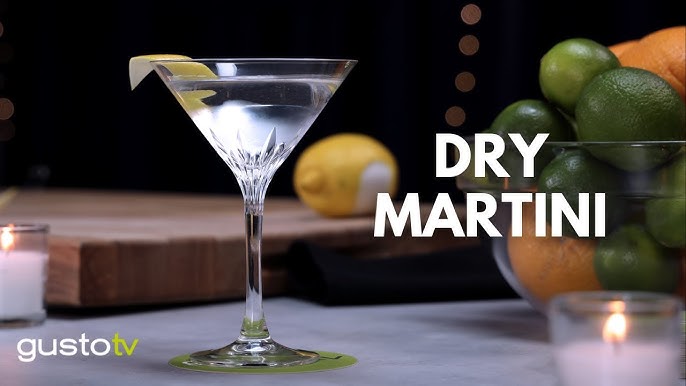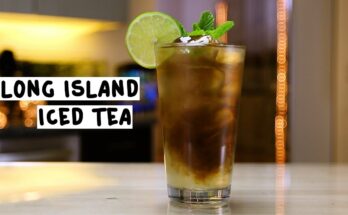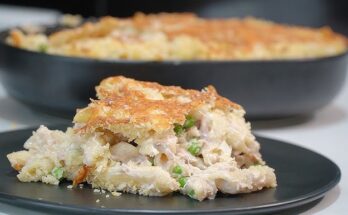Classic Martini Cocktail Recipe: The Martini cocktail is more than just a drink—it’s an experience, a symbol of sophistication, and a timeless classic that has held its crown for over a century. With its clean taste, crystal clarity, and sharp elegance, the Martini stands tall as one of the most iconic cocktails in the world. Whether you’ve seen James Bond order it “shaken, not stirred,” or you’ve admired the delicate martini glass at a high-end bar, this cocktail is a statement in itself.
But what makes the Martini so special? It’s not just about gin, vodka, or vermouth—it’s about balance. The Martini has only a handful of ingredients, but when crafted with precision, it delivers a crisp, refreshing, and slightly botanical flavor that lingers on the palate. Its simplicity is its power, and that’s why bartenders and cocktail enthusiasts consider it the true test of skill.
In this guide, we’ll take you through everything you need to know about making the perfect Martini at home. From its fascinating history to the right ingredients, tools, and step-by-step instructions, you’ll learn how to craft this elegant cocktail like a pro. Whether you prefer it dry, dirty, or with a twist, by the end of this article, you’ll be ready to shake—or stir—your own Martini masterpiece.
History of the Martini Cocktail
The Martini’s origins are a mix of mystery and legend. Some say it was born in the late 1800s in San Francisco, where a bartender mixed gin and vermouth for a gold miner heading to the town of Martinez. Others claim it was first made at New York’s Knickerbocker Hotel in the early 1900s. Regardless of its birthplace, one thing is certain: the Martini quickly became the drink of choice for the stylish and powerful.
During the Prohibition era in the United States, the Martini soared in popularity. Gin was easier to produce than whiskey, and with vermouth on hand, bartenders created a cocktail that masked imperfections while still delivering a strong kick. By the mid-20th century, the Martini had secured its spot as the ultimate cocktail of sophistication.
The Martini’s allure only grew with its role in pop culture. Hollywood embraced it, and silver-screen legends like Humphrey Bogart and Frank Sinatra were often pictured with a martini glass in hand. Then came James Bond, who immortalized the phrase, “Shaken, not stirred,” making the Martini synonymous with class and coolness.
Today, the Martini isn’t just a cocktail—it’s a cultural icon. From upscale bars to home gatherings, its elegance continues to attract new generations of cocktail lovers.
Understanding the Classic Martini
So, what exactly makes a Martini “classic”? At its core, a traditional Martini is made with gin and dry vermouth, stirred with ice, and garnished with either a lemon twist or olives. The balance between the spirit and vermouth defines the drink’s personality—more vermouth makes it lighter and more aromatic, while less vermouth results in a stronger, sharper flavor.
But here’s where the debate begins: gin versus vodka. Gin brings herbal, botanical flavors that add complexity, while vodka offers a cleaner, smoother taste. Purists argue that the Martini should always be gin-based, but vodka martinis have their loyal fans, especially since Bond’s famous preference.
Another defining element is dryness. A “dry martini” means less vermouth, while an “extra dry” martini may use just a drop or none at all. On the other hand, a “dirty martini” includes olive brine, giving it a salty edge.
Ultimately, the classic Martini is about preference and precision. It’s a blank canvas where tiny changes—gin vs vodka, stirred vs shaken, lemon twist vs olives—completely transform the drink. And that’s exactly why it has stayed relevant for over 100 years.
Ingredients You’ll Need
The beauty of a Martini lies in its simplicity. You don’t need a dozen ingredients or fancy syrups—just a few quality components make all the difference. Here’s what you’ll need for a classic Martini cocktail:
Core Ingredients
- Gin (or Vodka) – The foundation of the Martini. Choose a high-quality spirit with clean, smooth flavors.
- Dry Vermouth – Adds depth, aroma, and complexity to balance the spirit.
- Ice – Essential for chilling and dilution.
Garnish Options
- Lemon Twist – Provides citrusy brightness.
- Olives – Adds a savory, salty kick.
Choosing the Right Gin or Vodka
- For gin: Go for a London Dry gin like Beefeater, Tanqueray, or Bombay Sapphire for that classic crispness.
- For vodka: Opt for premium brands like Grey Goose, Belvedere, or Ketel One for a silky finish.
The Importance of Vermouth
Vermouth is not just a filler—it’s the soul of the Martini. Use a high-quality dry vermouth like Dolin, Noilly Prat, or Martini & Rossi. Remember to refrigerate vermouth once opened, as it’s a fortified wine that loses its flavor over time.
Final Touch: The Garnish
The garnish is more than decoration—it defines the Martini’s style. A lemon twist brightens the drink with a zesty aroma, while olives give it a briny, savory edge. Some enthusiasts even add a cocktail onion, creating the Gibson Martini.
With these simple yet refined ingredients, you’re ready to craft a Martini that rivals any upscale bar.
Essential Tools for Making a Martini
To make the perfect Martini, you don’t need a professional bar setup, but a few key tools will make the process easier and more precise:
- Cocktail Shaker or Mixing Glass – While martinis are traditionally stirred, some prefer them shaken. Both methods require the right tool.
- Bar Spoon – Helps stir smoothly without breaking the ice.
- Jigger – Ensures accurate measurements of gin/vodka and vermouth.
- Strainer – Essential for keeping ice shards out of the glass.
- Martini Glass – The iconic V-shaped glass that elevates presentation.
These tools not only make preparation effortless but also add a sense of ritual to crafting your Martini. After all, making a cocktail should feel just as stylish as drinking it.
Step-by-Step Guide to Making a Classic Martini
Making the perfect Martini isn’t about complexity—it’s about precision. Each detail matters, from the temperature of the glass to how you stir the liquid. Let’s walk through the process step by step so you can confidently mix your own at home.
Step 1: Chill Your Glassware
Before you even start mixing, place your martini glass in the freezer for at least 10 minutes. A frosty glass helps keep your drink crisp longer. If you don’t have time, fill the glass with ice and water while you prepare the cocktail, then discard before pouring.
Step 2: Measure and Pour Your Ingredients
Use a jigger to measure:
- 2 ½ oz gin (or vodka)
- ½ oz dry vermouth
Pour them into a mixing glass filled with ice. The accuracy of these measurements keeps the Martini balanced—too much vermouth and it’s overly floral, too little and it’s just a glass of cold gin.
Step 3: Stir or Shake – Which is Better?
The classic Martini is stirred, not shaken. Stirring ensures clarity and silky texture, while shaking makes it cloudier and slightly more diluted. Still, if you like it Bond-style, shaking adds extra chill and a bit more aeration.
Step 4: Strain Into the Glass
Using a cocktail strainer, carefully pour the drink into your chilled martini glass. This step is crucial because no one wants tiny shards of ice floating around.
Step 5: Add the Perfect Garnish
Decide your Martini’s personality:
- A lemon twist adds fresh citrus aroma.
- A pair of green olives gives it a savory punch.
And there you have it—the classic Martini, elegant and timeless.
Martini Variations You Should Try
Once you’ve mastered the classic, it’s time to explore some exciting variations. Each one has its own flair and flavor profile.
Dry Martini
Uses less vermouth (sometimes just a few drops). It’s bolder, sharper, and appeals to those who love a spirit-forward drink.
Dirty Martini
Adds olive brine to the mix, giving the drink a salty, savory twist. Perfect for those who like complexity and a bit of bite.
Vodka Martini
Clean, smooth, and slightly less complex than the gin version. Ideal for people who prefer a milder, sleeker cocktail.
Gibson Martini
Instead of olives or lemon, this variation uses a pickled cocktail onion as garnish, offering a unique, slightly sweet-savory kick.
These variations prove that the Martini is not just one drink—it’s a family of cocktails with something for every taste.
Perfect Food Pairings with a Martini
A Martini is elegant on its own, but pairing it with the right food enhances the experience. Here are some of the best pairings:
Appetizers That Complement Martinis
- Stuffed olives (especially blue cheese stuffed)
- Deviled eggs
- Prosciutto-wrapped melon
Seafood and Martini Combinations
- Oysters on the half shell – their briny flavor mirrors the crispness of the Martini.
- Smoked salmon canapés – rich, silky, and balanced by the cocktail’s dryness.
- Shrimp cocktail – refreshing and light.
Martini and Cheese Pairings
- Aged cheddar for sharpness
- Goat cheese for creaminess
- Parmesan for its salty depth
With the right bites, your Martini transforms into a complete dining experience, not just a drink.
Common Mistakes to Avoid When Making a Martini
Even though the Martini seems simple, small errors can completely ruin it. Avoid these common pitfalls:
Over-Dilution
Stirring too long or adding too much ice makes the Martini watery. Aim for about 30 seconds of stirring.
Wrong Vermouth Ratio
Using too much vermouth makes it taste wine-heavy, while too little creates an unbalanced drink. Stick to the 5:1 spirit-to-vermouth ratio as a starting point.
Poor Garnish Choices
Using low-quality olives or skipping the garnish entirely strips away the Martini’s personality. Always use fresh lemon or premium cocktail olives.
By steering clear of these mistakes, you’ll ensure every sip of your Martini is as refined as it should be.
Tips for Serving the Perfect Martini at Home
If you want to impress your guests—or simply elevate your own evening ritual—presentation is everything.
Glassware and Presentation
Always serve in a chilled martini glass. The V-shape isn’t just stylish—it keeps the drink cool and lets the aromas rise.
Keeping Your Martini Crisp and Cold
- Freeze your glass ahead of time.
- Use large, solid ice cubes to minimize dilution.
- Serve immediately after mixing—this drink isn’t meant to sit around.
Entertaining Guests with Martinis
Set up a mini martini bar with different garnishes, premium gins and vodkas, and quality vermouth. Let guests customize their drink while you handle the mixing—it turns cocktail-making into part of the evening’s entertainment.
Martinis in Popular Culture
Few cocktails have left as big a mark on pop culture as the Martini. This elegant drink has been immortalized in movies, TV shows, and literature, becoming a symbol of sophistication and power.
James Bond’s Influence
When Ian Fleming’s James Bond ordered his martini “shaken, not stirred,” it instantly became part of cocktail history. Though purists argue that a true Martini should be stirred, Bond’s line gave the drink an aura of danger and refinement. The association with the world’s most famous spy elevated the Martini into a lifestyle choice, not just a cocktail.
Hollywood and the Martini Lifestyle
Beyond Bond, Hollywood’s golden age embraced the Martini. Icons like Humphrey Bogart, Frank Sinatra, and Marilyn Monroe were often pictured with the signature V-shaped glass in hand. In classic films, the Martini became shorthand for wealth, class, and glamour.
Even today, TV series like Mad Men and modern films continue to use the Martini as a visual cue for sophistication. Ordering one signals style, confidence, and timeless taste.
Gin vs Vodka Martini Debate
The biggest Martini debate of all time? Gin or vodka.
Flavor Differences
- Gin Martini: Offers complexity thanks to botanicals like juniper, citrus peel, and herbs. It’s aromatic, layered, and slightly earthy.
- Vodka Martini: Smooth, clean, and straightforward. It doesn’t overpower the palate, making it more approachable for many drinkers.
Which One Suits You Better?
If you enjoy bold, herbal notes, a gin martini is your best bet. If you prefer sleek simplicity, the vodka martini will feel more refined. Neither is wrong—it’s entirely down to personal taste.
Interestingly, bartenders often say that the choice between gin and vodka reveals a lot about someone’s personality. Gin drinkers are seen as adventurous and classic, while vodka martini fans are often described as modern and minimalistic.
Health Aspects of Drinking Martinis
A Martini might not be a health drink, but compared to sugary cocktails, it’s surprisingly light.
Calories and Nutrition Facts
A standard Martini contains about 180–200 calories, mostly from alcohol. With no mixers, syrups, or sugar, it’s much lower in carbs than cocktails like margaritas or daiquiris.
Moderate Drinking Benefits vs Risks
- Benefits: Some studies suggest moderate alcohol consumption (one drink a day for women, two for men) can reduce stress and support social bonding.
- Risks: Overconsumption leads to liver damage, impaired judgment, and long-term health risks. Martinis are strong, so pace yourself.
Enjoying a Martini occasionally can fit into a balanced lifestyle, but moderation is the golden rule.
FAQs about Classic Martini Cocktail Recipe
1. Can you make a Martini without vermouth?
Technically yes, but it won’t be a true Martini. Without vermouth, you’re essentially drinking chilled gin or vodka in a fancy glass.
2. What’s the best garnish for a Martini?
It depends on your taste. A lemon twist adds brightness, while olives bring a savory punch. For something unique, try a cocktail onion in a Gibson Martini.
3. Can you pre-batch Martinis for parties?
Absolutely. Mix gin/vodka and vermouth ahead of time, keep it chilled in the fridge, and pour over ice when serving. Add garnishes just before serving to keep them fresh.
4. What’s the difference between a dry and dirty Martini?
A dry martini has less vermouth. A dirty martini includes olive brine, making it salty and savory.
5. Should a Martini always be stirred instead of shaken?
Traditionally, yes—it keeps the drink clear and silky. But if you like Bond’s way, shake it! At the end of the day, it’s all about preference.
Conclusion
Making one at home doesn’t require a professional bartender’s skills—just good ingredients, the right tools, and a touch of precision. From its fascinating history to its pop culture influence, the Martini isn’t just about flavor; it’s about the story it tells every time you raise that iconic glass.
So next time you want to impress your guests—or simply treat yourself—reach for the Martini. One sip, and you’ll understand why it has remained the king of cocktails for over 100 years.



